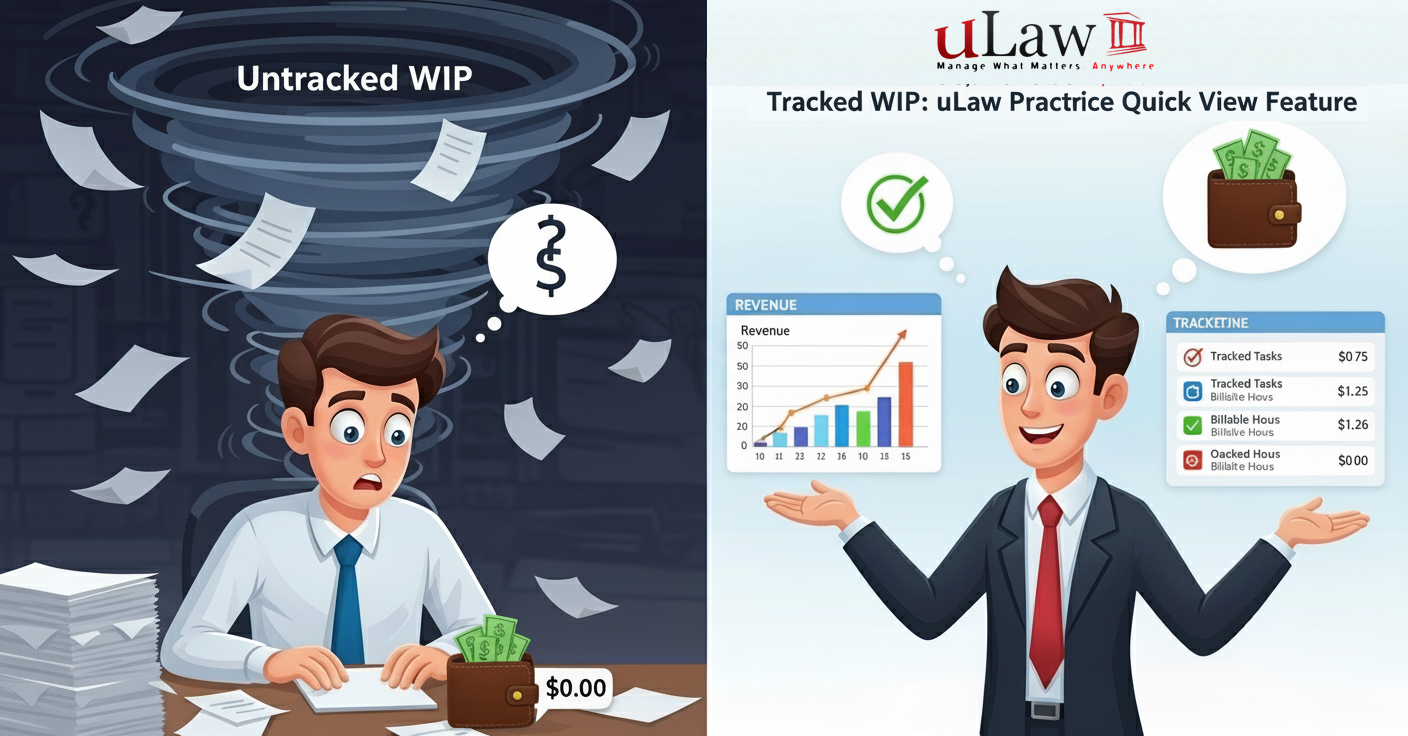Maximizing Profitability: The Power of uLaw Quickview and Work In Progress for Legal Professionals

For legal professionals, converting work into realized revenue is the core of a sustainable practice. Work In Progress (WIP), defined as unbilled fees and disbursements, represents a significant asset that, if managed poorly, can lead to lost revenue and audit headaches. Integrated practice management and accounting solutions like uLawPractice provide tools, such as the Quickview/Analytics dashboards and WIP reports, that are crucial for efficient financial management and increased billable time.
Understanding Work In Progress (WIP)
WIP is a critical metric that shows the value of the legal services and expenses already incurred for a client matter but not yet invoiced. It consists of two main components:
- Unbilled Fees (Billable Hours): The value of the time docketed by the legal professional for a matter.
- Unbilled Disbursements: Expenses paid by the firm on behalf of the client (e.g., court filing fees, process server costs, expert witness fees) that have not been reimbursed.
Key Benefits of uLaw QuickView + WIP for Legal Professionals
Below is a breakdown of how legal professionals can benefit, and how the features tie together.
1. Real‑Time Awareness of Billable & Disbursement Status
With QuickView and WIP reports, you can at any moment see:
- How many hours / time remain unbilled on a matter
- How many disbursement costs are incurred but not yet billed
- How these compare to budgets or estimates
- Which tasks, staff, or phases are lagging
This visibility helps you pivot earlier (e.g. accelerate billing, adjust staffing, or communicate with clients about overages).
2. Prevent Lost Fees & Disbursements
One of the biggest leakage points in legal billing is forgetting to bill. Time slips remain unbilled; disbursements are overlooked. WIP reports highlight these items BEFORE invoices go out — giving you a chance to clean up the matter and ensure full billing.
3. Optimize Cashflow & Predict Revenue
By knowing how much is unbilled, you can forecast upcoming invoices and cash inflows. If you see $5,000 in unbilled legal work and $1,200 in disbursements, you know your potential invoice before finalizing it. If that number is trending downward (i.e. WIP isn't turning into invoices fast), you can investigate.
4. Manage Client Expectations & Communication
If a matter is running over budget, WIP gives you continuous feedback. You can alert the client proactively (“We’ve incurred an additional $X in disbursements; we’ll invoice that next month”) rather than surprising them at the end. This improves trust and reduces billing disputes.
5. Internal Monitoring & Performance Analysis
Within the firm, WIP reports can be used to:
- Compare staff or team billing performance (who has more unbilled time?)
- Identify bottlenecks (e.g. work is done but not billed because someone hasn’t finalized it)
- Assess matter profitability (billable time + recoverable disbursements vs. write‑offs)
6. Better Invoicing Decisions
Before generating an invoice, you can review the WIP listing and decide:
- Which items to include or hold
- Whether any adjustments or write‑downs are needed
- Whether to bundle minor disbursements or break them out
- Whether to defer billing some items to align with client expectations
How a Legal Professional Uses this in Practice (Workflow)
- Record time and expenses diligently. Make sure all tasks, disbursements are entered into uLaw as soon as performed.
- Monitor QuickView regularly (daily, weekly) to see WIP accumulation.
- Run WIP reports filtered by matter, date, staff — to catch anything unbilled.
- Review WIP entries before billing — decide whether to include all, some, or adjust.
- Check retainer / trust balances vs. invoice amount.
- Generate invoice with confidence, knowing nothing is overlooked.
- Use analytics (which matters generate large WIP, which staff lag, which clients underpay) to improve process.
The video emphasizes a strategic approach to maximizing law firm revenue by closely intertwining Work in Progress (WIP) reporting with trust (retainer) balance monitoring. It demonstrates how real‑time insight into unbilled hours and disbursements—via the WIP report—reveals hidden billing opportunities, while simultaneously comparing that to the client’s trust balance ensures the firm can confidently draw on those funds. By doing so, attorneys can more proactively convert unbilled work into revenue, avoid revenue leakage, manage client expectations for retainer top-ups, and reduce the risk of write‑offs.

